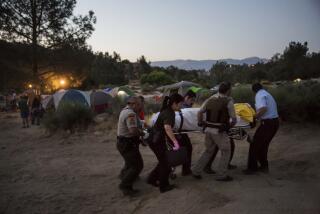Pools, Children Equal Danger
- Share via
If parents with young children and backyard swimming pools need more reasons to be aware of that potentially deadly combination, Dr. Ralph Rucker has about 1,000 of them. That’s how many county youngsters, mostly under age 4, will nearly drown in pool accidents this year.
Dr. Rucker, who heads the county’s only pediatric intensive care unit at Childrens Hospital of Orange County, sees a lot of them because Orange County, to his outspoken frustration, leads all counties in the nation in drownings and near drownings. In fact, a recent study disclosed that the leading cause of accidental deaths of children between the ages of 1 and 4 in Orange County and the rest of the state is no longer auto accidents. It’s drownings. Every year throughout the state, 140 youngsters under the age of 4 drown and 40 more are confined to institutions with permanent brain damage from near-drownings.
In 1984 in Orange County, 11 children drowned. Seven others are semicomatose in Fairview State Hospital because of near-drownings.
Those are grim statistics. But they are even more depressing, considering that most of the accidents could have been prevented and the number of deaths and disabilities reduced. What it takes are adults who are more attentive and cautious and know how to administer mouth-to-mouth and cardiopulmonary resuscitation (CPR) in those precious few moments between the time the child is discovered and pulled from the pool and the paramedics arrive.
Rucker can’t stop people with children under 5 from building swimming pools in their backyards or buying homes that have them, although he would like to.
The laws requiring pool owners to enclose their backyards with fences may prevent some deaths, but they don’t work well enough, as accident statistics indicate. That’s why Rucker and the Trauma Society recently launched a pool drowning prevention program, Protect Our Kids.
The program uses a puppet show and coloring books to make preschoolers aware of pool dangers and to teach them safety rules for survival, rules they can take home so that their parents, too, will be reminded of the hazards. It also seeks to encourage pool builders and suppliers to install warning signs in as many as possible of the 100,000 backyard pools in the county. The signs will detail the hazards to children and how to administer resuscitation. The approach deserves community support.
The Protect Our Kids program won’t eliminate pool drownings, but it could help reduce them by teaching children some life-saving do’s and don’ts around a swimming pool. And, more important, by impressing upon parents the need for constant vigilance wherever a pool and a youngster share a backyard.
More to Read
Sign up for Essential California
The most important California stories and recommendations in your inbox every morning.
You may occasionally receive promotional content from the Los Angeles Times.













